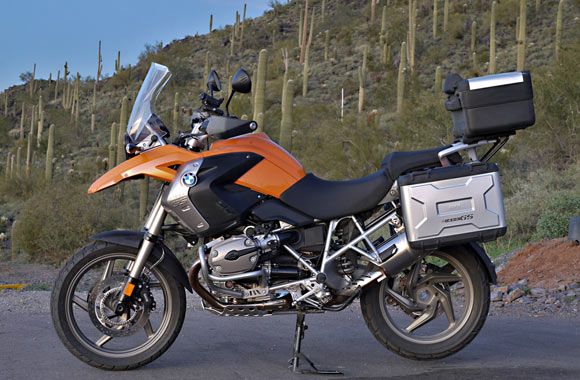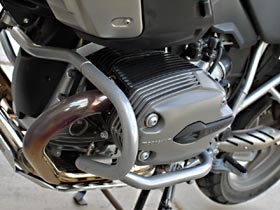Click above for a gallery of the 2009 BMW R 1200 GS
The rapidly expanding adventure-touring motorcycle genre is easiest to understand when you equate it to the booming sport-utility segment of the late '90s. However, unlike the majority of SUVs that hit the roads at the end of the last decade, today's adventure bikes actually posses equal parts sport and utility. The Bavarian motorcycle maker kick-started the category with the seminal R 80 G/S in 1980 and today, it dominates the class. In the interim, the GS line has undergone a series of upgrades, switching from airhead to oilhead engines in 1994 and expanding its range of single and twin-cylinder bikes, including the F 650 GS, F 800 GS and the penultimate R 1200 GS Adventure.
The 2009 R 1200 GS is the culmination of BMW's efforts and the genre as a whole. Since its introduction in 2004, the range-topping GS has been updated to include a revised servo-less ABS braking system, a slight bump in power and the addition of Electronic Suspension Adjustment (ESA). But the revisions don't tell the whole tale. What's it like to live with the GS for a week? Let's find out...
Photos Copyright ©2009 Jeremy Korzeniewski / Weblogs, Inc.
Nobody would describe the R 1200 GS as a "pretty" machine. It definitely looks interesting, but the GS' form isn't as stylish as BMW's own K-Series line of bikes. Regardless, we'll take purposeful over pretty any day of the week, and our time at the helm proved that the GS is designed this way for good reason, with the notable exception of the dual front head lights, which lend a quizzical look the the Bimmer's face. Whatever your opinion of its styling, the GS shares its genes with both the classic GS bikes of yore and the rest of BMW's current line.

Our GS tester came equipped with a bevy of storage options, including dual factory side cases and a top-mounted trunk. Although they don't do any stylistic favors to the profile of the machine, these three storage units made living with the bike considerably more bearable and generally displaced the need to use the car for daily errands. Each box is weatherproof, comes with a liner and is expandable. We never ran out of space, despite lugging around our camera gear for the duration of its stay, and even over the roughest of roads, the bags never made their presence known, negating the need to remove them.


For the 2008 model year, BMW made plenty of upgrades to the 1170cc air- and oil-cooled boxer mill that resulted in an increase from 100 to 105 horsepower. Torque stayed the same at 85 lb-ft, though the power peak moved a bit further up the tach to coincide with the redline, which was increased from 7,750 to 8,000 RPM. The six-speed transmission's gearing was revised and now features both slightly shorter ratios and a final drive. Riders that are familiar with BMW transmissions will notice an improved shifting feel, but the experience is still a bit notchy, with a firm-sounding metallic clunk accompanying each gear shift. It's far from a Japanese engagement, but we never missed a gear and neutral was reassuringly easy to locate both coming down from second and up from first.
Riding the GS is an enlightening experience, proving that a bike can be all things to all people. We spent a few hours out on the open highway where the GS was perfectly adept at avoiding SUVs and semis, with a perfectly smooth ride when approaching triple-digit speeds. Up front, a GS-specific windshield can be moved up and down, changing the rake and altering the wind flow over the rider's head, assuming said rider is under six-feet tall. A larger windscreen is available as an accessory and may prove beneficial for riders planing long stretches of high-speed tours across the continent.




On more pedestrian city streets, the big BMW seems to morph from a long-distance tourer into something closely resembling a standard. You'll never mistake the big GS as a sport bike, but we found that it had plenty of power to blow past the morning traffic and take a spot at the front of the line. Its ABS-equipped brakes and Automatic Stability Control help keep everything pointed in a straight line around town and proved invaluable when the roads turned twisty. We found plenty of cornering clearance despite the twin cylinders jutting out past the rest of the bike, although riders who aren't used to BMW's classic boxer powertrain may need a few days to become properly acquainted with those wide heads. But overall, most will find it's a non-issue after the first few rides.
Much of GS' success on the roadways can be attributed to its extremely capable and fully adjustable suspension. BMW continues to use its trademark Telelever design up front and the Paralever setup out back, and after refining these bits for years, everything seems to be perfected. There's no unwanted movements from either end, even under the most harrowing on- and off-throttle moments.

As previously mentioned, BMW has equipped the range-topping GS with a new Enduro ESA suspension setup. A switch on the left handlebar allows the pilot to toggle through settings for riding alone, riding with luggage or riding with a passenger. These modes adjust the preload of the rear shock in accordance with how much weight is over the back tire. Keep pressing and you'll find Normal, Comfort and Sport modes that are all designed for the street. Each setting changes the way the bike feels from the saddle, with Comfort mode providing a slightly mushy ride for the superslab and Sport firming things up when road goes every which way but straight.
Additionally, the R 1200 GS features a few new modes to BMW's electronic suspension adjustment designed specifically for off-road conditions. Pressing and holding the ESA button switches things to Enduro mode, which opens up two new settings -- Medium Reserve and Maximum Reserve – with small and large mountain icons to match. Now, choosing between Soft, Normal and Hard will adjust the preload of both the front and rear shocks, raising the ride height a full 20 millimeters in the Hard setting. This is the mode we used for most of our off-road riding where hard landings were a regular occurence. We also switched the ABS off while running around on the dirt, one of the few times when siding the rear is actually desirable.

The off-road capability of the GS is truly amazing, especially considering how well it works on the road. Our first introduction to what would prove to be an eye-opening day was on a ten-mile dirt road that you'd normally take at about 15 mph in a car. We had no problem tripling that speed on the GS. After the first few miles, we found ourselves purposely aiming for dips and ruts just to feel the bike lose contact with the road and touch back down with zero drama. These conditions proved to be a perfect playground to showcase what this bike is really capable of.
Later, we took the GS through some rugged scenery that would be tough to traverse on foot, and the GS rarely placed a tire wrong. The seat, foot pegs and handlebar are perfectly situated to allow the rider to stand up under gnarly conditions, and there's plenty of ground clearance to allow for fallen log (or cactus) crossings. If the big bike is undone by any single type of terrain, it's sand. We figure that a real set of knobbies (like those fitted to the Adventure model) would make a big difference if you'll regularly be riding in sand or soft dirt.

The GS carries a stiff price of just over $15K, which quickly rises after desirable options like the ESA system, ABS and heated grips are added. But if you can swing the sticker, you'll be rewarded with a machine that will tackle off-road conditions with nearly as much aplomb as it does on the street. If you could only have one motorcycle for the rest of your life, you could do much worse than the GS.

Special thanks to Go AZ Motorcycles for providing a test bike.


Sign in to post
Please sign in to leave a comment.
Continue